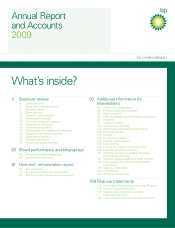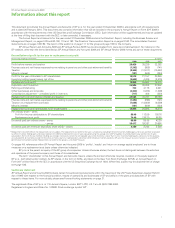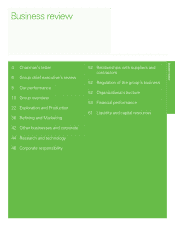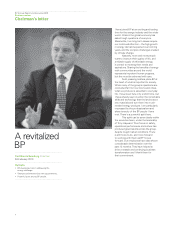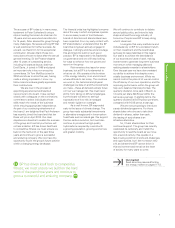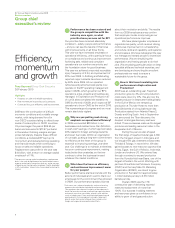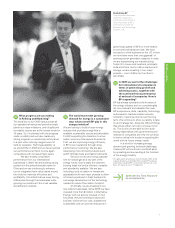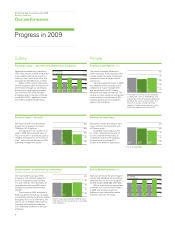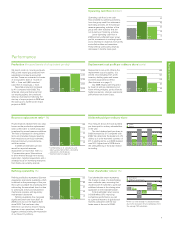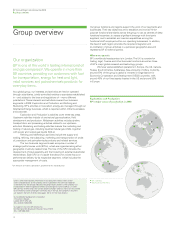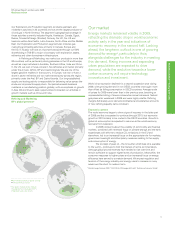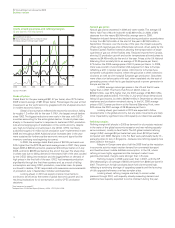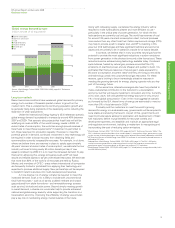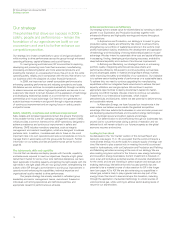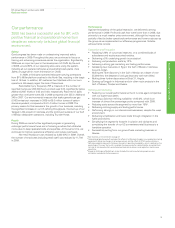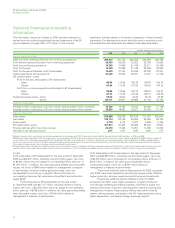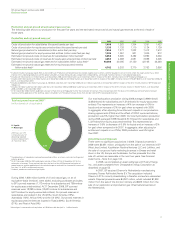BP 2009 Annual Report Download - page 9
Download and view the complete annual report
Please find page 9 of the 2009 BP annual report below. You can navigate through the pages in the report by either clicking on the pages listed below, or by using the keyword search tool below to find specific information within the annual report.
7
Business review
Revitalizing BP
Tony Hayward discusses
priorities, results and
continuous improvement
with employees at BP’s
International Centre for
Business and Technology,
Sunbury, UK.
What progress are you making
in Refi ning and Marketing?
The transition to full OMS status across all
our operated refi neries and petrochemicals
plants is a major milestone, and oil spills and
recordable injuries are at the lowest levels for
10 years. So, I’m pleased with the progress
made on safety and we have made very
strong progress on operational performance
in a year when refi ning margins were hit
hard by recession. Refi ning availability is
up around 5% on 2008 and we have restored
our performance so that it is once again
competitive with our supermajor peers.
We saw a really competitive
performance from our international
businesses in 2009. We are building strong
positions in the petrochemicals market in
China and we are continuing to enhance
our six integrated fuels value chains around
the world to maximize effi ciency and
profi tability. It is critical that we keep driving
effi ciencies through the businesses while
growing our positions in the most valuable
and attractive markets.
The world must meet growing
demand for energy in a sustainable
way; what role will BP play in this
energy evolution?
We are looking to build a future energy
industry that provides energy that is
available, sustainable, secure and affordable.
For BP, supporting the transition to a low-
carbon economy has several dimensions.
First, we are improving energy effi ciency
in BP’s own operations through close
performance monitoring. We are also
developing more effi cient products such
as BP Ultimate fuels and Castrol lubricants.
Second, we are promoting a greater
role for natural gas as a key part of the
energy future. Gas is easily the cleanest
burning fossil fuel and is effi cient, versatile
and abundantly available. We are also
including a cost of carbon in investment
appraisals for all new major projects to allow
informed investment in fossil fuels and to
encourage development of the technology
needed to reduce their carbon footprint.
And fi nally, we are investing in our
low-carbon businesses. Since 2005 we have
invested more than $4 billion in Alternative
Energy, with our activity focused on four
key areas. We are investing in advanced
biofuels, which are low cost, scalable and
sustainable, and can provide reductions in
greenhouse gases of 80% or more relative
to conventional transport fuels. We have
focused our wind business on the US, where
we now have more than one gigawatta of
spinning power generation capacity. In solar,
we are repositioning our manufacturing
footprint to lower-cost locations, principally
India and China. And in carbon capture and
storage, we are investing in two major
projects – one in California, the other in
Abu Dhabi.
In 2009 we saw further challenges
for international oil companies in
terms of generating growth and
achieving access, together with
the continued strong emergence
of national oil companies. How is
BP responding?
BP has always operated at the frontiers of
the energy industry and our core strengths
are more relevant and valuable than ever.
BP’s experience, skills, capability, technology
and access to markets enable resource
holders to maximize returns over the long
term. We continue to show our ability to take
on and manage risk, doing the diffi cult things
that others either can’t do or choose not to
do. This is why we are able to form such
strong relationships with governments and
national oil companies and why we continue
to have a critical role to play in supplying the
world with its future energy needs.
In a world of increasing energy
demand and growing technical challenges,
I believe BP will continue to set itself apart
by operating and succeeding at the frontiers
of the energy industry.
a O n a gross joint-venture basis (which includes 100% of the
capacity of equity-accounted entities where BP has partial
ownership). Including BP’s share of joint ventures on a net
basis, the capacity was 711 megawatts.
Speeches by Tony Hayward
bp.com/speeches

